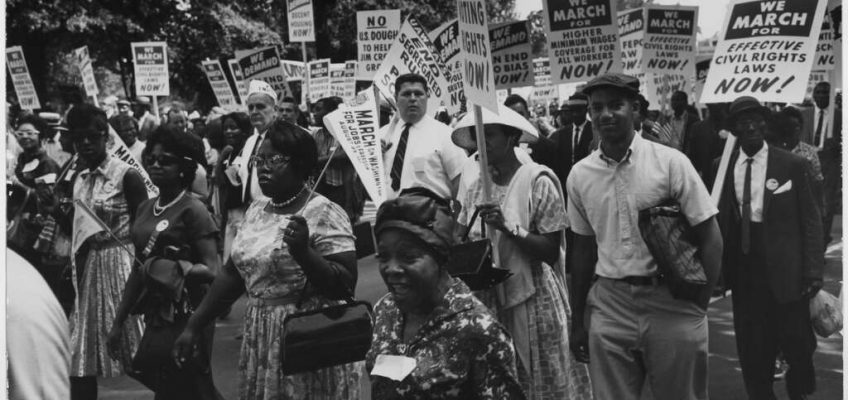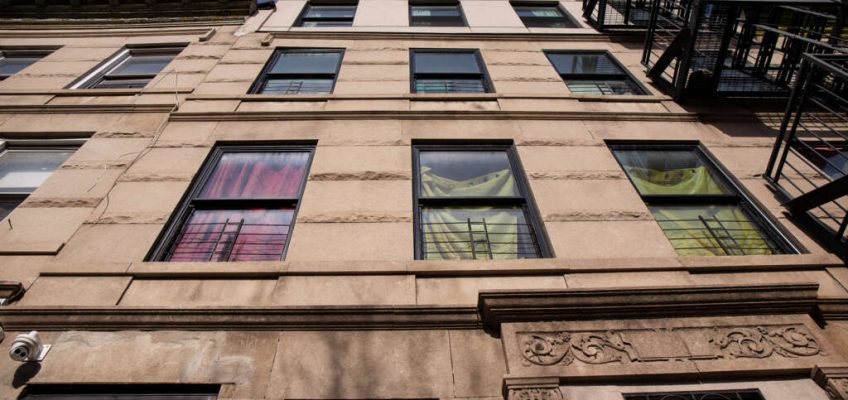City Limits combed through city government and non-profit documents and spoke to experts to get their take on what renters can do if they’re struggling to make rent, or facing the threat of eviction.
Apartments in Brooklyn. (Adi Talwar/City Limits)
Are you struggling to afford your apartment? Worried that you won’t make rent? Has your landlord served you an eviction notice?
You’re not alone. Since the end of New York’s COVID-19 eviction moratorium in 2022, eviction rates have increased significantly. According to data compiled from the city’s marshals, there were 9,615 evictions from January through June in 2025, up 18 percent from the same period in 2024, and up 474 percent from 2022.
If you’re worried about being included in those statistics, this guide is for you. City Limits combed through city government and non-profit documents and spoke to experts—Jenny Laurie, the executive director of Housing Court Answers, and Danelly Rodriguez, an experienced housing attorney—to get their take on what renters can do if they’re struggling.
We’ve divided this information into sections depending on where someone is in the process, including:
Steps to take at any time
If you just missed a rent payment or were served a rent demand letter
Before or at your first court date
After a judgement has been issued against you
The good news? “ Most cases don’t end up in evictions,” said Laurie of Housing Court Answers, which assists tenants navigating the housing court system.
The numbers back her up. In fiscal year 2024 (July 1, 2023 – Jun 30, 2024) 126,236 eviction cases were filed in court, but only 14,934 evictions were carried out during that period.
Read on for more tips and information. (Editor’s Note: This article is educational and does not constitute specific legal advice; for that, you should consult a lawyer—more on how to find one is included below).
Steps to take at any time
See if you’re eligible for Cash Assistance or a One Shot Deal, and apply if you are
There are multiple housing assistance programs that serve New York City residents. However, many require you to be enrolled in either one of these programs first, if you are eligible: Cash Assistance and the One Shot Deal.
Cash Assistance is meant to help low-income New Yorkers in need cover necessary costs of living expenses. Payments through this program are ongoing, and can be applied to costs outside of rent and housing. There are a number of income eligibility and need requirements to qualify. A guide on the documents you can submit, depending on what you need to prove, can be found here.
One Shot Deals are one-time payments to help New Yorkers cover an unexpected or emergency cost, including emergency rental expenses. Unlike Cash Assistance, One Shot Deals often need to be paid back over time.
Both programs require the majority of applicants to be engaged in work or training for a set minimum number of hours per week to be eligible.
Applications for both are available on the New York City Human Resources Administration’s Access HRA platform. You can also apply on the Access HRA mobile app, which is available for both iOS and Android.
Peeling paint in a Bronx apartment. (Adi Talwar/City Limits)
Start documenting your living conditions and communication with your landlord
Eviction is a legal process, so having a lawyer can help immensely. Rodriguez, an experienced housing attorney and tenants rights advocate at Legal Services NYC, says there are multiple defenses against eviction, even in cases of non-payment. However, all need to be backed up with evidence.
“When we don’t have a paper trail it’s very difficult for us to really aggressively take a position,” during negotiations or potential settlement discussions, Rodriguez said. “So I can’t stress the importance of this enough: documentation, documentation.”
Particular actions he suggests are:
Documenting all interactions with your landlord about repairs and the state of the apartment
Making calls to 311 for any violations you see
Taking pictures of any violations or hazardous conditions
Making sure all agreements between you and the landlord are preserved in writing
You can start documenting at any point in the eviction process. So don’t hesitate: get everything in writing. Take photos of the conditions of your apartment and report any violations to 311.
See if you’re eligible for heating and cooling assistance
Another benefit available to qualifying low-income New Yorkers that could potentially help is the Home Energy Assistance Program, or HEAP. HEAP provides both regular payments and emergency benefits to help with heating bills, as well as the purchasing of heating and cooling equipment (like the purchase of an air conditioner or fan in the summer). There is no requirement to be on Cash Assistance to qualify.
Unfortunately, funding is limited and tends to run out each season, and the program’s future is uncertain, as the Trump administration looks to cut its staff and resources. Applications for the cooling assistance program this summer already closed on June 23. The application period for the heating benefit normally begins in early to mid-November and continues through winter until funding is exhausted, according to the state.
Request your rent history and see if your apartment is rent stabilized
Rent stabilization is a form of rent regulation that applies to roughly 1 million units in New York City. If an apartment is rent stabilized, tenants are provided a number of protections against eviction, and have expanded rights. Rent increases are also limited by New York State law.
Generally, apartments in buildings that were built before 1974 and have six or more units are rent stabilized. However, before New York passed stricter regulations in 2019, there were a number of ways to destabilize units or buildings. There are also some newer buildings which are stabilized because they received tax breaks under the J-51 and 421-a programs.
Landlords are required to register their regulated units each year, and the state’s Division of Housing and Community Renewal (DHCR) maintains a database of those properties, though not all building owners keep those records up to date. A new law will soon also require landlords to post public notices in common areas that inform tenants if there are rent stabilized units in the building.
Another way to find out is to request your apartment’s rent history. To do this, you can fill this web form from New York State’s Division of Homes and Community Renewal. Once sent, you should receive your rent history within 20 business days. Your landlord is not notified that you made this request.
A Bronx residential building with rent-stabilized apartments on the corner of East Mosholu Parkway North and Kossuth Avenue. (Adi Talwar/City Limits)
If you just missed a rent payment or were served a rent demand letter
A landlord can’t just throw you out: they have to follow particular procedures, and those procedures take time. In a nonpayment case, landlords need to notify you in writing if rent is more than five days late, and properly serve you at least a 14-days notice (sometimes called a rent demand letter), before they can start the eviction process and take you to court (that doesn’t mean you have to leave in 14 days; the case is just starting.)
Respond to the notice of petition
The start of an eviction case officially begins after your landlord serves you a “notice of petition” and “petition.” After these are properly served, you are given an opportunity to respond by filing an answer, or speaking to a court clerk.
If you don’t respond, the consequences can be disastrous, according to Laurie.
“If a tenant doesn’t respond and the landlord pursues the [eviction] case, they can get a default judgment. Once they get a default judgment, they can ask the court for an eviction warrant. Once they get the warrant, they can go to a marshal and have the tenant physically evicted from the apartment,” she explained. “In some places [it takes] a couple of months to get a judgment and a warrant if the tenant does nothing.”
So if your landlord serves you a notice, it’s crucial that you respond. Directions for answering both general and nonpayment petitions can be found here.
See if you’re eligible for rental assistance through CityFHEPS or FHEPS
New York has two main rental assistance programs, CityFHEPS and FHEPS. Both provide ongoing cash supplements that pay a portion of your rent, if you’re eligible; checks are sent directly to your landlord, and can be applied to the cost of your current apartment, or a new apartment. The main difference between them are the qualifying standards.
According to the city’s Department of Social Services (DSS), FHEPS is meant for families with children or victims of domestic violence. To qualify for FHEPS, households must be receiving Cash Assistance and include a child under 18, someone over 18 who is a full time student at a secondary school or is in technical training, or someone who is pregnant.
CityFHEPS, on the other hand, doesn’t require that a household include children. If your household income is less than 200 percent of the federal poverty line and meet one of four scenarios—like if you live in a rent-controlled apartment and have an active eviction case, or were already evicted within the last year—you may qualify.
Households that include a veteran who is at risk of homelessness, or are receiving Pathway Home benefits, or were referred to the program by the city’s Department of Social Services may also qualify. To be accepted into the program, you must be receiving Cash Assistance, so apply for that first if you’re eligible and haven’t already.
If you are currently living in a Department of Homeless Services shelter, the qualifications and application process differ; those details can be found here.
To apply to FHEPS, go to the Access HRA website. To apply for CityFHEPS, find and contact a Homebase provider near you using this link.
Check if you’re being overcharged
If you can’t make rent because of a significant price hike, make sure the rent increase is legal. This will depend on the type of apartment you have: rent stabilized or “fair market.”
Rules for rent increases in stabilized apartments are firmly established. Rent increase maximums are set by the Rent Guidelines Board, which votes on them each year. Currently, the maximum annual increase for a rent stabilized apartment is 2.75 percent for a one-year lease, and 5.25 percent for a two-year lease (though leases starting in October 2025 will be eligible for new rates: 3 percent on one-year leases and 4.5 percent on two-year leases.)
Either way, if you live in a rent stabilized unit and your rent was increased above those percentages, that could be used as a possible defense against eviction in court.
A rally for the “good cause” eviction bill, which passed the state legislature last year. (Chris Janaro/City Limits)
There are also new protections for some market rate tenants. New York’s “Good Cause” eviction law, passed in 2024, sets a reasonableness standard—called the “local standard”—for maximum rent increases for non-regulated housing.
“Reasonableness” is defined as a baseline 5 percent increase, plus inflation, with a maximum increase set at 10 percent. The current local standard in New York City is 8.79 percent—so if your rent was increased above that rate, and your apartment is regulated by Good Cause, you may have a defense against eviction in court. Dannelly noted, however, that the case law surrounding the reasonableness standard is limited so far, since the law is still new.
“Under [good] cause, if you’re going to increase the rent more than the legal limit allowed under the law, the landlord has to provide a good explanation and one of those good explanations is the landlord needs to make repairs,” Dannelly said. “We don’t know what other potential good explanations might exist, because the way the law’s written, it gives judicial discretion to the judges to decide what those things are.”
There are other carveouts, too: generally to qualify, your landlord must own 10 or more other units, and your unit must have been built before 2009. If you’re unsure about your apartment’s status, the non-profit housing advocacy group JustFix offers this online tool, which will help you determine if your unit is covered under the law.
Before or at your first court date
At this point, your landlord has given you notice of eviction, and you’re about to appear in court or have done so already. Most of the actions and programs listed above are still accessible to you. There is, however, one restricted to those who are appearing at court: Right to Counsel.
New York City’s “Right to Counsel” law provides free legal help to low-income tenants in housing court who are facing eviction. You can find income eligibility thresholds here.
For those who can access it, it’s an effective resource: According to a 2025 report by the Community Service Society,* evictions are down 26 percent since passage of the law in 2017, which the report’s authors attribute to “Right to Counsel, local anti-harassment laws, and the 2019 rent laws” that are “working in tandem.”
The implementation hasn’t been perfect, though. Many eligible tenants still face housing court alone due to funding limits, a lack of available attorneys, and the fast rate of calendering cases in housing court, as City Limits previously reported.
“Free access to counsel through the Right To Counsel program is only appointed to your case on the day of your court appearance,” Rodriguez explained. “So, at the first court appearance where your court date has been established there are lawyers in the courtrooms, for the most part—some days we’re not there—to conduct intake on every single person that’s coming in to see if they qualify for legal services and if they do qualify for legal services, they will be appointed an attorney.”
He also underscored that talking to an attorney could be helpful at any point in the process. The number for Legal Services NYC is 917-661-4500. Tenants can also call the city’s Tenant Helpline for questions about their rights and access to legal help.
People entering Brooklyn Housing Court at 141 Livingston St. on the morning of March 20, 2023. (Adi Talwar/City Limits)
After a judgement has been issued against you
Keep advocating for yourself in court
A judgment against a tenant in a housing court case does not guarantee that the tenant will be evicted. Judges have discretion, and even if you’ve been found liable, there are options. Laurie said that in her experience, even when tenants receive judgments against them, they are often given time to pay back their owed rent.
“The typical case of a tenant without an attorney is a settlement agreement written in housing court by the landlord’s attorney, consulting with the tenant, and going before the judge or the judge’s court attorney to sort of iron out any difference,” Laurie said.
If the tenant can’t pay the rent by that deadline, they can still advocate for themselves, and argue for extra time. “The judge needs a good reason to give you more time, and then on top of that, you also have to say that if I’m given more time, I will be able to do these three things to get [the rent money],” Laurie added.
An extension might be granted, for example, if a tenant has applied for aid programs but hasn’t received the help yet because of administrative delays. “You would just provide the documentation showing that you’ve applied for assistance, and that it’s out of your control,” Laurie said.
Tenants who come to court unprepared generally fare worse, she added. “ You’ll see someone who comes to court and the judge will ask, ‘Did you apply for a one shot deal?’ ‘No, I meant to, but I didn’t do it.’ ‘Do you have a second job? Do you have a new job? Do you have any kind of way to pay the rent? Did you get a roommate?’” Laurie said. “And they haven’t done anything since the last court appearance; that person’s a lot less likely to get more time. They don’t have any concrete reasons why they didn’t make progress on paying the back rent.”
If the court ultimately issues a judgement against you, you’re unable to pay your rent back and your motions are rejected by a judge, then the eviction can likely proceed. The judge will sign a warrant of eviction, and you’ll be served with a notice. In 15 days or more, a city marshal can then carry out the eviction (marshals can either perform an “eviction” or a “possession.” In an eviction, both the tenant and the contents of the apartment will be removed, and the locks will be changed to prevent entry. In a possession, your belongings will be left in the apartment.)
More information on eviction procedures can be found at the New York City Marshal’s eviction FAQ page.
*Community Service Society is among City Limits’ funders.
To reach the editor, contact Jeanmarie@citylimits.org. Want to republish this story? Find City Limits’ reprint policy here.
The post What You Need to Know If You’re Struggling to Pay Rent in NYC appeared first on City Limits.




